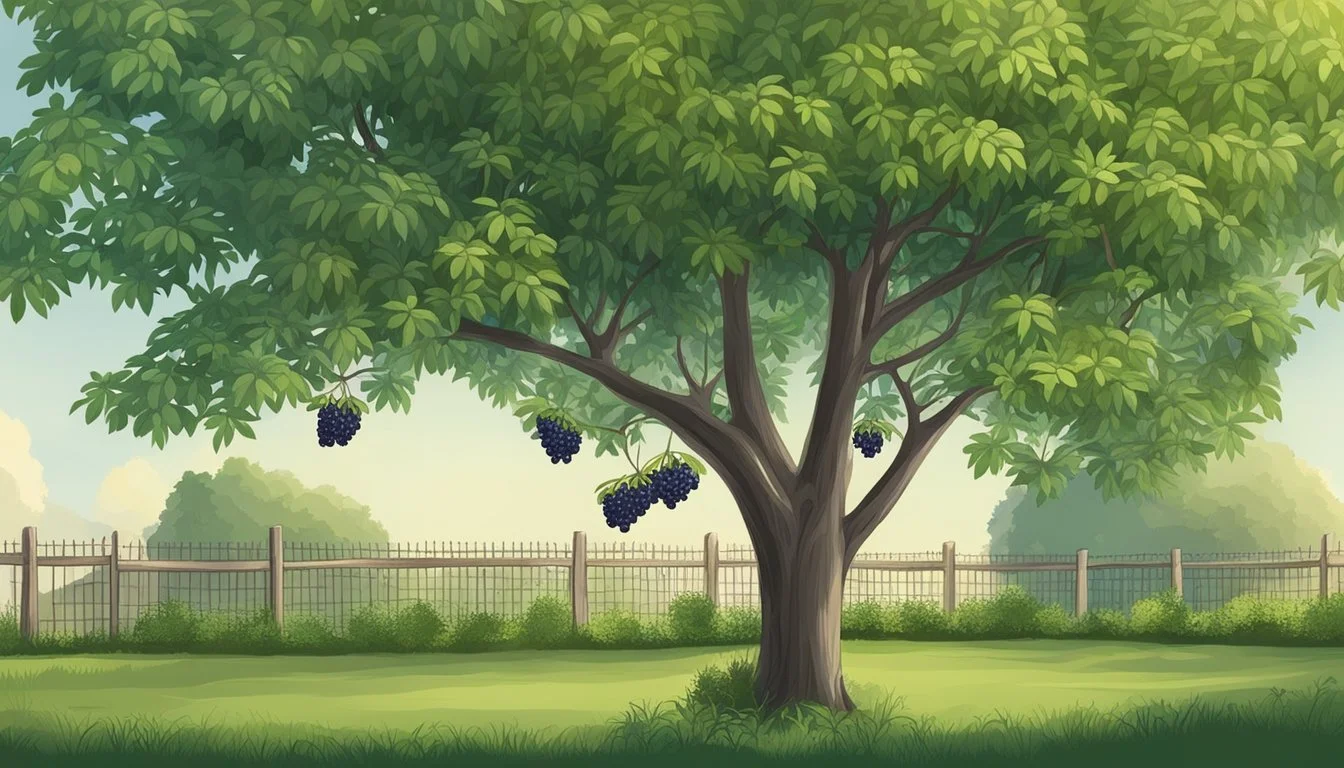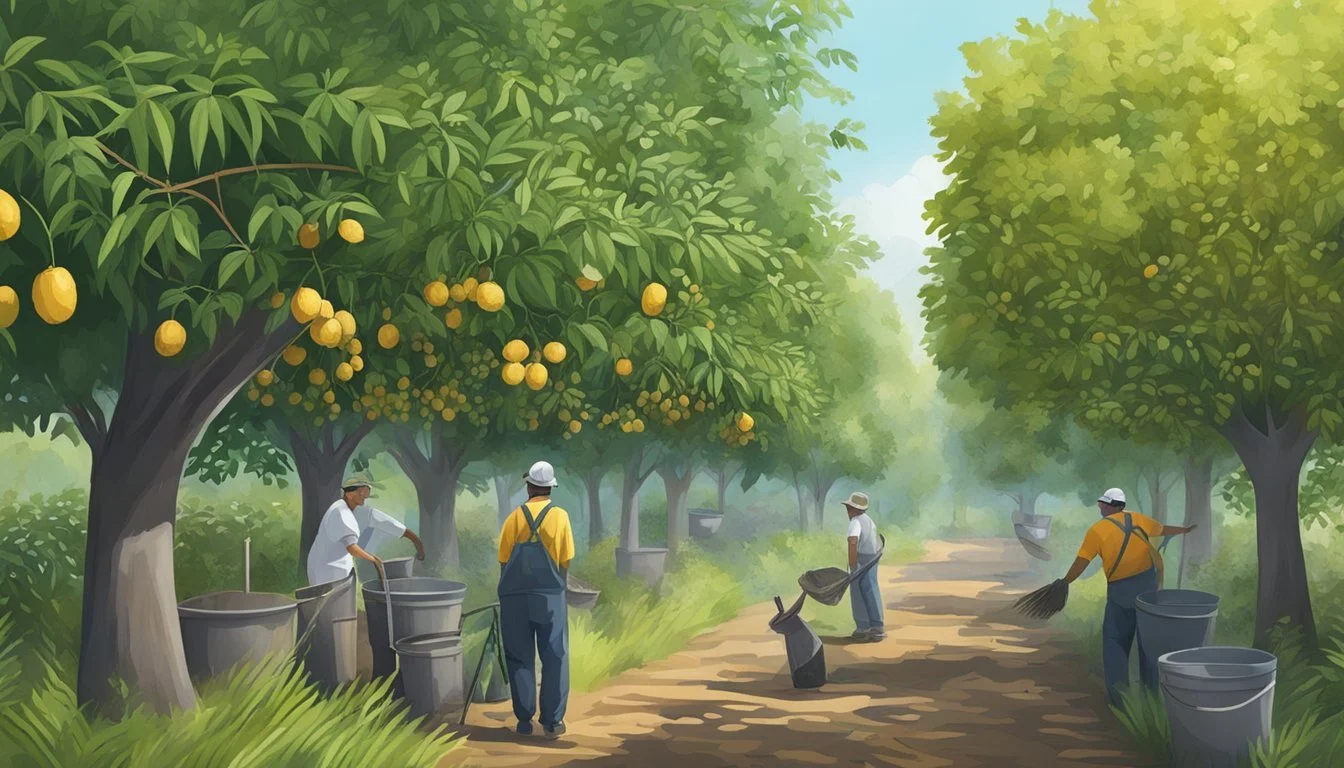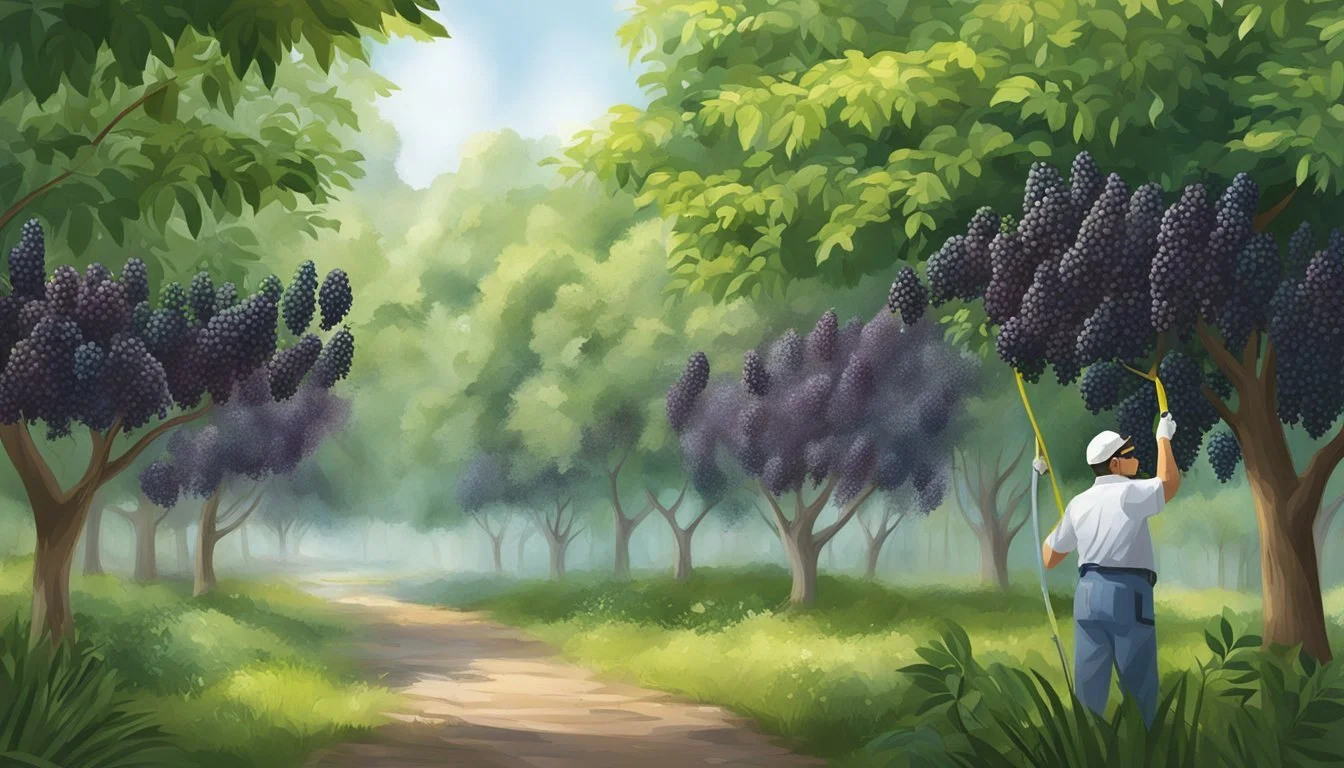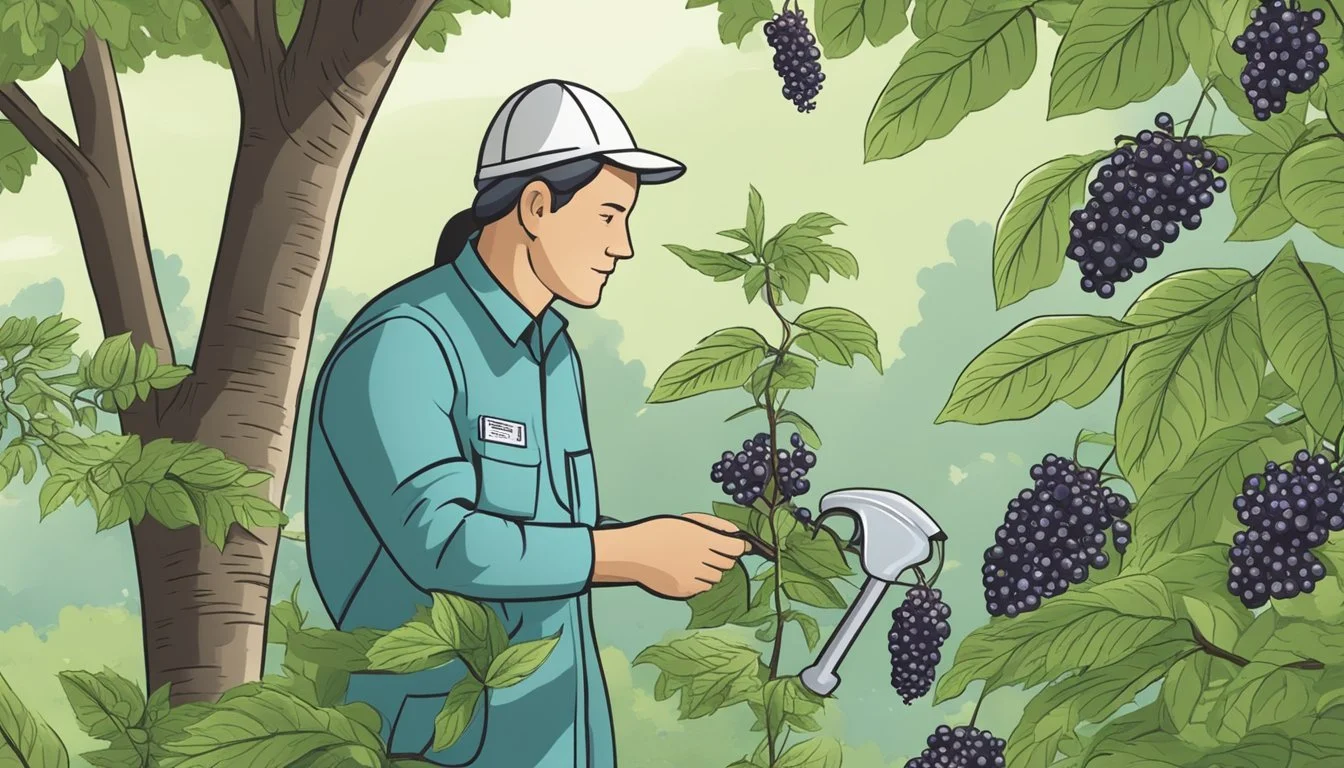Pest Control for Elderberry Trees
Effective Strategies and Solutions
Elderberry plants are valued for their ornamental beauty and bountiful harvests, often used to make wines, syrups, and jams. However, like all plants, they are susceptible to various pests and diseases that can compromise their health and productivity. Effective pest control is crucial for ensuring the vitality of these trees, as it not only influences the quality and quantity of their yields but also their overall longevity.
Proper identification of the pests that target elderberry trees is the first step toward managing these unwelcome visitors. Common pests, such as aphids, spider mites, and the elderberry borer, can cause significant damage and stress to the plants. Tactics for controlling these pests range from cultural practices, like selecting disease-resistant varieties and proper maintenance, to the careful application of pesticides as a last resort.
Integrated pest management strategies are recommended for elderberry cultivation; these combine regular monitoring, use of natural predators, and environmentally sensitive chemicals when necessary. The goal is to minimize the impact of chemical use on the environment and beneficial organisms while providing adequate protection for the elderberry plants. Maintaining healthy elderberry trees through good practices helps to ensure they can better resist pests and diseases, ultimately leading to a thriving crop.
Understanding Elderberry Trees
Elderberry trees, known for their clusters of dark berries and numerous health benefits, are a valuable addition to any garden. They thrive under proper conditions and offer both ornamental and practical uses.
Botanical Profile of Elderberry
Elderberry refers to a variety of plants within the Sambucus genus, with Sambucus nigra (black elderberry) and Sambucus canadensis (American elderberry) being the most prominent. Sambucus nigra is a deciduous shrub native to Europe, famed for its medicinal properties, whereas Sambucus canadensis originates from parts of North America. Both species produce small, white-to-cream flowers that develop into the purplish-black fruit. The plants are hardy, fast-growing, and can reach a height and spread of up to 12 feet.
Cultivating Elderberry in Your Garden
Incorporating elderberry plants into a garden calls for understanding their growth requirements. Elderberries thrive in locations with full sun to partial shade and require well-drained soil with a pH between 5.5 and 6.5. As a deciduous shrub, elderberry adds to the landscape with its lush foliage and clusters of fragrant flowers, which later turn into the fruit. Gardeners often use elderberries as ornamental plants, while the berries can be harvested to make syrups, jams, and wine. Regular pruning is suggested to maintain plant health and enhance fruit production.
Site Selection and Planting
When selecting a site for elderberry plants and undertaking the planting process, it is crucial to consider factors such as light requirements, soil type, and water availability to ensure the plants thrive.
Choosing the Right Location
Elderberry plants require a location with full sun to light shade to prosper. Proper sun exposure encourages robust growth and berry production. They are adaptable to different lighting conditions but ideally should receive at least six hours of direct sunlight per day. Elderberries also need to be planted in an area that accommodates their size at maturity, spacing them 10-15 feet apart to avoid overcrowding and to ensure sufficient air circulation.
Soil Preparation and Planting Guidelines
The success of elderberry plants begins with soil preparation. They prefer well-drained soil with plenty of organic matter. Before planting, test the soil to ensure a pH between 5.5 and 6.5 and amend accordingly. To plant, dig a hole twice as wide as the root ball and equally as deep. Elderberries do well with a rooting hormone applied to cuttings to enhance root development. After setting the plant in the hole, refill with soil, firming gently to eliminate air pockets. Finish by watering thoroughly to establish good root-to-soil contact, which is essential for proper growth. Regular to moderate amounts of water support healthy plants, without causing waterlogged conditions that can lead to root issues.
Care and Maintenance
Proper care and maintenance are crucial for the health and productivity of elderberry trees. Attention to watering, nutrient management, and growth control can prevent many common pest and disease issues.
Watering and Mulching
Elderberry trees thrive with consistent moisture. They should be watered deeply, especially during dry periods, while avoiding waterlogging. A layer of mulch around the base of the tree can retain soil moisture and regulate temperature. Organic mulch, such as straw or wood chips, also adds organic matter to the soil as it decomposes.
Frequency: Weekly deep watering, more frequent during drought.
Mulch: 2 to 4 inches of organic material, avoiding direct contact with the trunk.
Fertilization and Nutrient Management
Balanced nutrient management is essential for elderberry trees. Apply a balanced fertilizer high in nitrogen in the early spring to support vigorous growth. Adding compost can improve soil structure and provide a slow-release source of nutrients.
Fertilizer: Balanced N-P-K ratio, applied annually in the spring.
Compost: Incorporate into the soil around the trees to boost nutrient levels and organic matter.
Pruning and Managing Growth
Pruning is necessary to maintain tree structure, remove dead or diseased leaves and branches, and promote air circulation. This helps to prevent fungal diseases and improves sunlight penetration. Prune elderberry trees in the winter when they are dormant.
Prune out: Dead, diseased, or crossing branches.
Growth management: Remove older stems to encourage new growth and better fruit production.
Pest and Disease Management
Elderberry plants require attentive management to prevent and control the pests and diseases that can affect their health and productivity. Employing an integrated approach with both preventive measures and treatments ensures that elderberries thrive.
Common Pests of Elderberry
Elderberries face threats from various insects that can diminish their growth. Key pests to monitor for include:
Aphids: Small sap-sucking insects that can cause leaf curling and are capable of transmitting viruses.
Elder Shoot Borer: Larvae that tunnel into new shoots, potentially killing the cane.
Japanese Beetle: Feeds on the leaves, leading to skeletonized foliage.
Eriophyid Mites: Cause galls and distortion of leaves and stems.
Detection of these pests at early stages is critical. They can typically be managed by regular monitoring, physical removal, or by using insecticidal soaps and oils which are less harmful to beneficial insects.
Identifying and Treating Diseases
Elderberry plants are susceptible to several diseases which can hinder their health. Common diseases include:
Leaf Spot: Fungi that cause dark spots on leaves, which can lead to defoliation.
Canker: Characterized by sunken, dead areas on stems and branches, which can girdle and kill canes.
Powdery Mildew: Appears as a white powdery substance on leaves and stems, inhibiting photosynthesis.
Prevention is a crucial strategy in disease management, including selecting resistant varieties and proper sanitation of pruning tools to avoid spreading infections. Infected parts of the plant should be removed and destroyed. Fungicides may be necessary for controlling severe outbreaks, but they should be applied according to label recommendations and local extension advice.
Elderberry Propagation Techniques
Elderberry plants can be propagated effectively through both sexual and asexual methods, each with its specific practices for successful cultivation and establishment.
Sexual Propagation: Seed Planting
Seeds are the product of sexual reproduction and pollination in elderberry plants. Propagating elderberries by seeds involves harvesting mature seeds from ripe elderberry fruits. To ensure successful germination, one should stratify the seeds by simulating winter conditions, usually done by placing seeds in moist sand and storing them in a refrigerator for about 90-120 days. After stratification, seeds are sown in a well-draining soil medium and should be kept consistently moist until germination.
Asexual Propagation: Cuttings and Layering
Asexual propagation includes the use of cuttings and layering methods, allowing for the exact genetic reproduction of the parent plant. For cuttings, one must identify and utilize healthy, disease-free branches. Softwood cuttings are typically taken in late spring, while hardwood cuttings are best harvested in the dormant season. The cut end may be treated with a rooting hormone to encourage root development and then planted in a moist soil mix or submerged in water until roots form.
Layering is another technique where a low hanging branch is intentionally bent to the ground and covered with soil while still attached to the parent plant. Over time, this branch will develop its own root system and can be cut from the parent to become a separate plant. Layering and cuttings are favored methods of propagation, as they are quicker and often more reliable than growing elderberry plants from seeds.
Maximizing Elderberry Yield
The quantity and quality of elderberry fruits can be significantly influenced by proper cultivation techniques. Two key factors in maximizing yield are the arrangement of plants to optimize space and light exposure, and the application of an Integrated Pest Management (IPM) strategy.
Optimal Spacing and Sun Exposure
For elderberry plants to achieve their best yield, they require full sun or light shade. Plants should be spaced adequately to ensure that each receives enough sunlight and air circulation, which are critical for the health of the plant and the maturation of the berries. Proper spacing also helps in reducing the spread of diseases and pests, which can negatively impact the yield. A general guideline is keeping plants 6 to 10 feet apart to provide ample room for growth and maintenance activities.
Integrated Pest Management (IPM)
IPM utilizes a combination of cultural, biological, and chemical practices to control insect pests and diseases, which can drastically reduce elderberry yields. By monitoring pest populations and applying controls only when necessary, elderberry farmers can maintain a high yield without over-relying on chemical treatments. Research indicates effective IPM practices for elderberry include removal of affected parts and the use of labeled organic controls before the leaf curl or infestation occurs. Focusing on preventive measures and natural controls can also sustain the health of Sambucus spp. and support successful pollination, which is vital for fruit set and yield.
Harvesting and Post-Harvest Processing
Elderberries require careful handling during harvesting and post-harvest processing to retain their quality, whether used for making syrups, jams, wine, pie, juice, or extracts. This section outlines best practices to harvest elderberry flowers and berries, as well as suggests methods for processing these components into various products.
Best Practices for Harvesting
Harvesting elderberries involves selecting ripe clusters of berries that have turned from red to a deep, dark purple color. They should be:
Plucked carefully: Use a gentle hand to avoid bruising the berries.
Harvested in dry conditions: To reduce the risk of mold and spoilage.
Collected using the appropriate tools: A pair of clean, sharp scissors or pruners can aid in cutting the clusters from the tree.
For elderflower harvesting:
Timing is crucial: Flowers should be collected when they are fully open and before they begin to turn brown.
Method of gathering: Flowers are typically snipped from the shrub using scissors, with only the flower heads being retained.
Processing Elderberries for Various Uses
After harvesting, processing elderberries promptly is imperative to prevent deterioration. Depending on the intended use, different methods of processing may be employed:
For syrup, jam, and wine: Berries must be destemmed, washed, and then cooked to ensure safety, as raw elderberries contain compounds that can be toxic.
Processing Method
Destemming
Washing
Cooking
Description
Berries should be removed from stems, which harbor toxic compounds.
Berries need to be rinsed under running water to remove debris.
Heat berries until they release juice, essential for making syrups and jams.
For pie and juice: Pulp extraction is essential. Berries are crushed to obtain pulp, which can be used as a pie filling or further processed to make juice.
Use
Pie
Juice
Processing Technique
Berries are crushed and sweetened to form a filling.
Extracted pulp is strained and mixed with other ingredients.
For extracts: The berries or flowers are typically infused in a liquid base like alcohol or glycerin to draw out their botanical compounds.
Remember that each use requires attention to the preparation stages to preserve the desired qualities of elderberries, whether capturing the delicate floral notes for beverages or ensuring the robust fruit flavor in preserves.
Using Elderberries
Elderberries have garnered attention for their versatility in the kitchen and their nutritional value. They are not only a staple for creating delicious foods like syrups and pies, but also hold a variety of health benefits. Here is how one can optimize the use of elderberries.
Health Benefits and Uses
Elderberries are rich in vitamins and antioxidants, offering numerous health benefits. They contain vitamin C, dietary fiber, and flavonoids that are known to support the immune system. Elderberry syrup is often used to alleviate cold and flu symptoms due to its anti-viral properties. Additionally, the presence of anthocyanins in elderberries promotes anti-inflammatory effects, which may help reduce the risk of chronic diseases.
Nutrient
Vitamin C
Dietary Fiber
Flavonoids
Anthocyanins
Benefit
Boosts the immune system
Helps in digestive health
Supports the immune system, reduces inflammation
Promotes anti-inflammatory effects
Recipes and Preparation Tips
When crafting elderberry recipes, one can create a spectrum of food items ranging from elderberry syrup for medicinal purposes to elderberry pie for a delightful dessert. Syrups are simple to make by cooking the berries with water and sugar, then straining the mixture. For baking purposes, elderberry jam can elevate pastries and bread. When making elderberry wine, they add a unique flavor profile that is both earthy and tart.
To ensure the safe consumption of elderberries, they must be cooked thoroughly, as raw berries can contain harmful compounds. Always heat elderberries before using them in any recipes to neutralize these compounds.
Preparing Syrup: Cook berries, then strain. Mix with sugar and boil.
Elderberry Pie: Fresh or dried elderberries can be used as a filling.
Elderberry Wine: Ferment elderberries with yeast for a unique homemade wine.
Remember, while enjoying the culinary aspects, one is also partaking in the nutritional advantages these small, yet mighty berries offer.
Understanding Elderberry Economics
In the context of commercial farming, understanding the economics of elderberry cultivation is crucial. It involves analyzing market trends and the relationship between costs and profits to assess the overall viability of elderberry farming.
Market Trends and Commercial Viability
The elderberry market has been experiencing growth due to increased interest in health and wellness products, where elderberries are recognized for their nutritional benefits. This trend is driven by consumer demand for natural and locally-grown products. The viability of commercial elderberry farming has strengthened as a result, with new entrants seeking to capitalize on this demand.
Yield is a significant factor in commercial farming, and elderberries offer the potential for high yields per acre. They can bear large crops of berries the second year after establishment, which contributes to quicker returns on investment when compared to some other crops.
Costs and Profits in Elderberry Farming
The profitability of elderberry farming hinges on managing both initial and ongoing costs effectively. Initial costs include land preparation, planting, and establishment of irrigation systems, if necessary. Ongoing costs consist of labor, pest and disease control, and harvesting.
Farmers typically see profits after the second year, with increasing margins as plants mature and yield more fruit. The balance between costs and revenue is critical; efficient practices in pest management and harvesting can be decisive in ensuring a profitable elderberry enterprise.
By maintaining a clear perspective on these economic factors, farmers can make informed decisions about whether to integrate elderberries into their crop portfolios.
Frequently Asked Questions
Effective pest control in elderberry trees is crucial to maintaining their health and productivity. These FAQs address common concerns with specific, actionable advice.
What are the common diseases affecting elderberry trees?
Elderberry trees are susceptible to several diseases, with Thread Blight being one notable example. This disease causes leaves to wilt, curl, and turn brown, especially in shaded areas of the plant.
How can neem oil be used in controlling pests on elderberry trees?
Neem oil, derived from the neem tree, can be an effective organic pesticide for elderberries. It helps control pests by disrupting their life cycle when applied directly on affected areas of the trees.
What are some natural methods for preventing pest infestations on elderberry trees?
Preventing pest infestations on elderberry trees can include regular pruning to promote sunlight penetration and air movement, as well as the removal of infected twigs and branches to prevent the spread of diseases like Thread Blight.
What are the signs of elderberry rust and how can it be treated?
Elderberry rust presents as yellow or orange spots on the leaves, often leading to defoliation. Treatments can involve the removal and destruction of affected parts to prevent further spread.
How do you effectively eliminate elderberry borer beetles?
Elderberry borer beetles require proactive monitoring. One should look for larvae in the stems during pruning and destroy any infested stems to effectively eliminate these pests.
What are the best practices for managing aphids on elderberry plants?
Managing aphids involves a combination of strategies such as encouraging natural predators, physical removal with a strong water jet, or the use of horticultural oils. Monitoring plants regularly for early aphid detection is critical.









